Are you wondering what are some shrimp safe fish ? As an aquarist, I’ve often faced the challenge of finding the perfect tank mates for my shrimps. While it’s true that no fish is completely shrimp
? As an aquarist, I’ve often faced the challenge of finding the perfect tank mates for my shrimps. While it’s true that no fish is completely shrimp safe, it is possible to create a harmonious community tank with the right choices.
safe, it is possible to create a harmonious community tank with the right choices.
In this comprehensive guide, we’ll explore the best shrimp safe fish, tips for maintaining a healthy environment, and how to avoid common pitfalls in shrimp and fish tanks .
.
Top Shrimp Safe Fish Tank Mates
Here is a small list of shrimp safe fish to get you started.(If you feed them enough)
fish to get you started.(If you feed them enough)
- Guppies (Poecilia reticulata)
- Endlers (Poecilia wingei)
- Neon Tetras (Paracheirodon innesi)
- Ember Tetras (Hyphessobrycon amandae)
- Pygmy Corydoras (Corydoras pygmaeus)
- Otocinclus Catfish
 (Otocinclus sp.)
(Otocinclus sp.) - Harlequin Rasboras (Trigonostigma heteromorpha)
- Celestial Pearl Danios (Danio margaritatus)
- Cloud Mountain Minnows (Tanichthys albonubes)
- Rice Fish (Oryzias latipes)
- Rummy Nose Tetras (Hemigrammus rhodostomus)
- Bristlenose Pleco (Ancistrus)
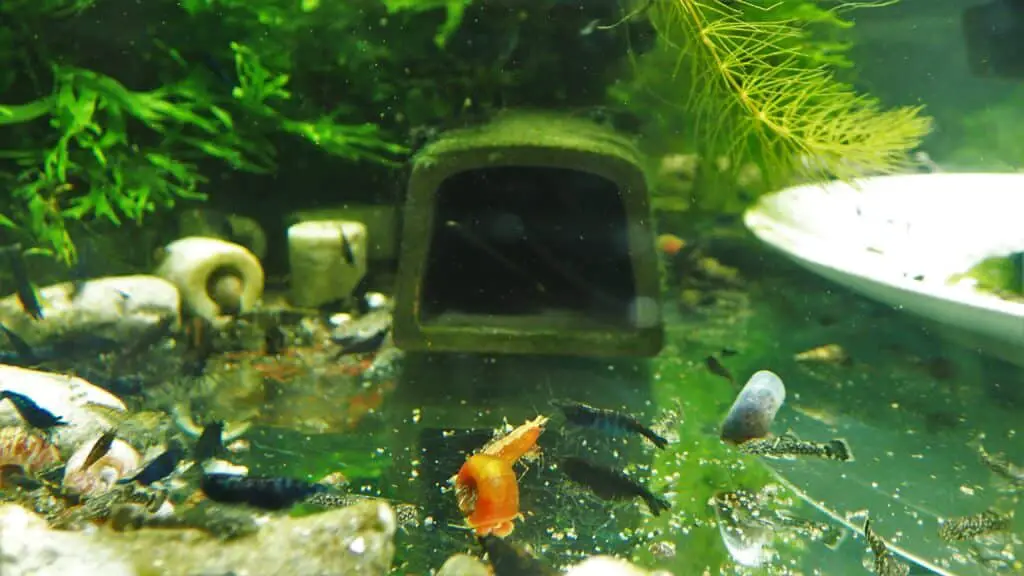
Guppies and Endlers: Colorful and Shrimp-friendly
Both guppy and endlers are small, peaceful fish that make great shrimp tank mates. With their vibrant colors and fascinating behavior, they can coexist well with cherry shrimps as long as they are well-fed.
Keep in mind the minimum tank size for these fish is 10 gallons/40 liters, and you should have plenty of hiding spots for your shrimp to feel secure. Endler make a great tank mate for shrimps .
.
Neon and Ember Tetras: Eye-catching and Compatible
Neon and Ember Tetras are another excellent option for shrimp safe fish. Their small size and peaceful nature make them well-suited for cohabitation with cherry shrimp. Just like with guppies and endlers, ensure that your tank has enough hiding spots and ample food to minimize predation.
safe fish. Their small size and peaceful nature make them well-suited for cohabitation with cherry shrimp. Just like with guppies and endlers, ensure that your tank has enough hiding spots and ample food to minimize predation.
Pygmy Corydoras: Tiny, Peaceful Bottom Dwellers
Pygmy Corydoras are tiny, peaceful catfish that make fantastic shrimp tank mates. They are bottom-dwellers that spend most of their time searching for food, making them less likely to prey on your shrimps. To ensure a harmonious environment, provide plenty of hiding places and maintain a tank size of at least 10 gallons.
tank mates. They are bottom-dwellers that spend most of their time searching for food, making them less likely to prey on your shrimps. To ensure a harmonious environment, provide plenty of hiding places and maintain a tank size of at least 10 gallons.
Otocinclus Catfish: Algae Eaters and Shrimp Companions
Otocinclus catfish are small, peaceful algae eaters that can coexist with shrimp in your aquariums. They spend most of their time grazing on algae and biofilm. A 10-gallon tank is the minimum size for these fish, and plenty of hiding spots are necessary to keep your shrimp safe.
Harlequin Rasboras: Stunning Schooling Fish
Harlequin Rasboras are attractive, peaceful schooling fish that can make great shrimp tank mates. They generally do not bother shrimp, especially when kept in a well-planted tank with ample hiding spots. A 10-gallon tank is the minimum size for these fish, but a larger tank is recommended to accommodate a small school.
Celestial Pearl Danios: Tiny Jewels for Your Shrimp Tank
Celestial Pearl Danios, also known as Galaxy Rasboras, are small, peaceful fish that can coexist with cherry shrimps. Their stunning colors and unique patterns make them an eye-catching addition to any shrimp tank. Be sure to provide enough hiding
spots and maintain a tank size of at least 10 gallons to ensure a harmonious environment for both your shrimp and Celestial Pearl Danios.
Rummy Nose Tetras: Active and Attractive Schooling Fish
Rummy Nose Tetras are an active, peaceful schooling fish that can coexist with cherry shrimps. Their distinctive red-nosed appearance makes them a visually appealing addition to your shrimp tank. Keep them in a well-planted aquariums with plenty of hiding places for your shrimp, and maintain a tank size of at least 20 gallons.
Cloud Mountain Minnows
Cloud Mountain Minnows, also known as White Cloud Mountain Minnows, are small, peaceful, and hardy fish that can coexist with shrimp. They are schooling fish, so it’s best to keep them in groups of six or more. Their attractive colors and patterns make them a popular choice for community tanks.
A well-planted tank with ample hiding spots will help keep your shrimp safe from predation. A minimum tank size of 10 gallons is recommended for these fish, although a larger tank is better for accommodating a school of Cloud Mountain Minnows.
Rice Fish
Rice Fish, also known as Japanese Rice Fish or Medaka, are another great shrimp-safe fish option. These small, peaceful fish can live harmoniously with cherry shrimp and other shrimp species. Rice Fish are hardy and can adapt to a range of water parameters, making them suitable for beginner aquarists.
and other shrimp species. Rice Fish are hardy and can adapt to a range of water parameters, making them suitable for beginner aquarists.
Provide a well-planted tank with plenty of hiding places for your shrimp, and maintain a minimum tank size of 10 gallons to ensure a comfortable environment for both your shrimp and Rice Fish.
Bristlenose Pleco: Efficient Algae Eaters for Larger Tanks
Bristlenose Plecos are a popular choice among aquarists for their algae-eating abilities and distinctive appearance. All though these fish are larger than the typical shrimp friendly fish, they can coexist with shrimp, I have them in tanks with thousands of neocaridina.
These catfish are nocturnal, meaning they are more active during the night, and will often hide during the day. To ensure a comfortable environment for both your shrimp and Bristlenose Plecos , provide plenty of hiding spots, such as caves, driftwood, and plants. Additionally, maintain a well-fed environment to reduce the chances of predation on your shrimps.
, provide plenty of hiding spots, such as caves, driftwood, and plants. Additionally, maintain a well-fed environment to reduce the chances of predation on your shrimps.
Although Bristlenose Plecos are primarily algae eaters, supplement their diet with sinking algae wafers, vegetables like zucchini, and occasional protein-rich treats to ensure proper nutrition. By providing the right conditions and diet, Bristlenose Plecos can be a beneficial addition to a shrimp tank, helping to keep algae growth under control.
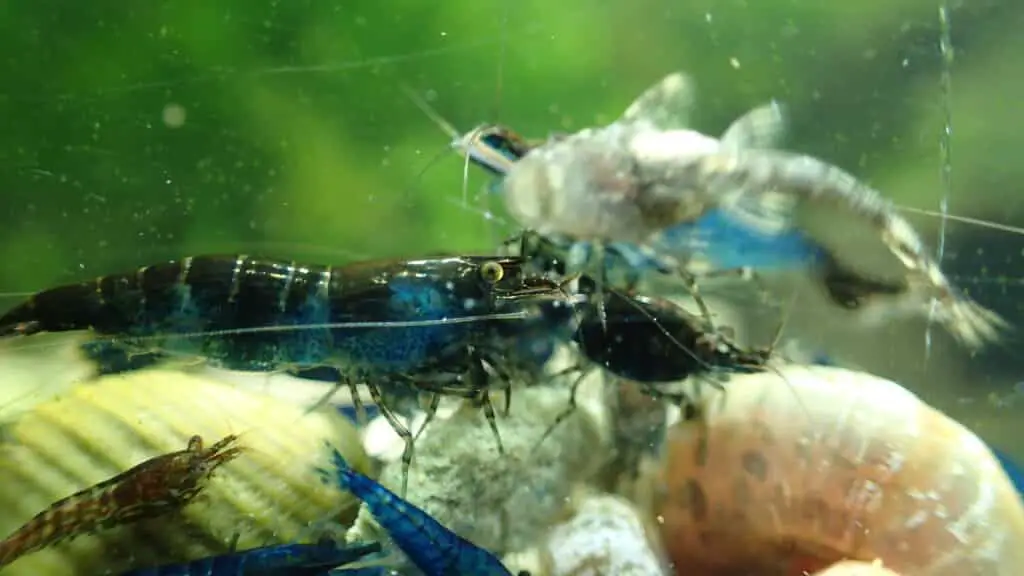
What type of shrimp can I keep with fish?
Creating a diverse and interesting shrimp and fish community tank starts with understanding the different shrimp species suitable for cohabitation with shrimp safe fish. Here are some common shrimp types that aquarists often keep with fish:
- Cherry Shrimp (Neocaridina davidi): Cherry shrimp are the most popular freshwater shrimp for community tanks
 . Their vibrant red coloration and hardy nature make them a favorite among aquarists. They are compatible with most shrimp safe fish and can thrive in a well-maintained environment.
. Their vibrant red coloration and hardy nature make them a favorite among aquarists. They are compatible with most shrimp safe fish and can thrive in a well-maintained environment. - Amano Shrimp
 (Caridina multidentata): Amano shrimp are known for their exceptional algae-eating abilities, making them a beneficial addition to any community tank. They are larger than cherry shrimp, which can help reduce the risk of predation by tank mates. Amano shrimp
(Caridina multidentata): Amano shrimp are known for their exceptional algae-eating abilities, making them a beneficial addition to any community tank. They are larger than cherry shrimp, which can help reduce the risk of predation by tank mates. Amano shrimp are compatible with most shrimp safe fish, but they require slightly cooler water temperatures and a well-aerated tank.
are compatible with most shrimp safe fish, but they require slightly cooler water temperatures and a well-aerated tank. - Ghost Shrimp (Palaemonetes spp.): Ghost shrimp are a transparent, inexpensive, and hardy shrimp species often kept with fish. They are compatible with most shrimp safe fish, It’s essential to provide ample hiding spots in the tank to ensure their safety.
- Bamboo Shrimp (Atyopsis moluccensis): Bamboo shrimp, also known as wood shrimp or flower shrimp, are a unique filter-feeding shrimp species. They are compatible with most shrimp safe fish, but they require a specific setup with proper water flow for filter feeding. A well-established tank with stable water parameters is necessary for their well-being.
- Snowball Shrimp (Neocaridina palmata): Snowball shrimp are a less common but attractive freshwater shrimp species known for their opaque white coloration. They are compatible with most shrimp safe fish and share similar care requirements with cherry shrimp. Snowball shrimp can add a unique visual element to your shrimp and fish community tank.
When choosing shrimp species for your community tank, consider their compatibility with your existing or planned fish, as well as their specific care requirements. Providing a suitable environment and understanding the unique needs of each shrimp species will ensure a thriving, diverse, and fascinating shrimp and fish community tank.
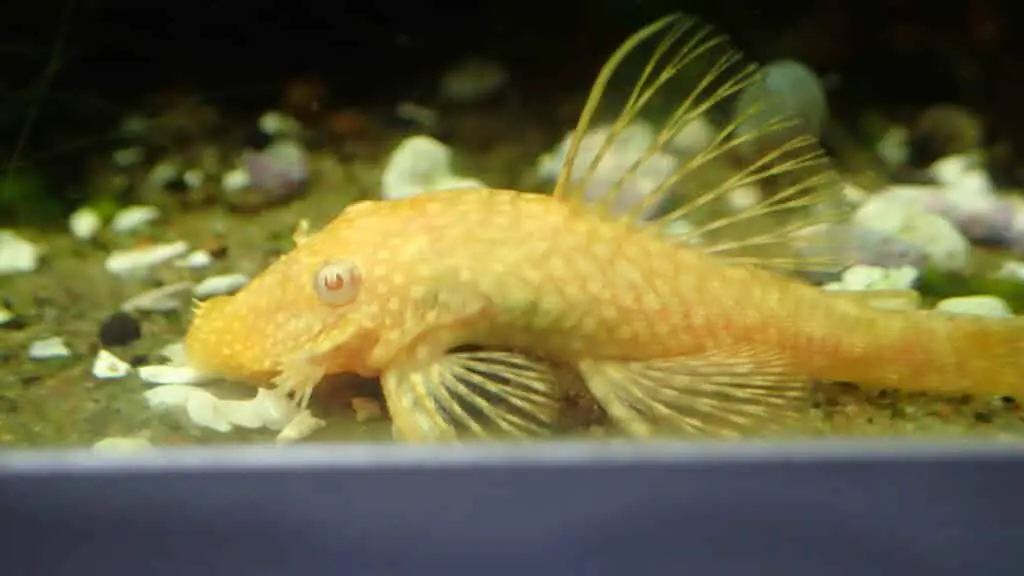
Tips for a Successful Shrimp Safe Fish Community Tank
- Ensure a spacious tank size for the number of inhabitants.
- Provide ample hiding spots, such as plants and decorations.
- Feed your fish regularly to reduce the likelihood of predation on shrimp.
- Avoid territorial or aggressive fish, like cichlids.
- Acclimate new additions to the tank carefully.
- Regularly monitor water parameters to maintain a healthy environment.
- Keep the aquariums well-planted to provide additional shelter and food sources for your shrimp
 .
.
Creating the Ideal Environment for Freshwater Shrimp and Fish
- Choosing the Right Tank Size
- Filtration and Water Parameters
- Substrate Selection
- Aquascaping for Shrimp and Fish
- Lighting Considerations
- Heating Your Aquariums
Choosing the Right Tank Size
It’s essential to select an appropriate tank size for your shrimp and fish community. While some shrimp safe fish can thrive in a 10-gallon tank, others may require larger fish tanks to accommodate their size or schooling behavior. As a general rule, a larger freshwater tank provides more stability, allowing your aquatic inhabitants to coexist peacefully.
Filtration and Water Parameters
A well-functioning filtration system is crucial to maintaining a healthy shrimp and fish community. Choose a filter that can handle the bioload of your tank and provide ample water movement without creating strong currents. Keep your water parameters stable, with a pH between 6.5 and 7.5, and maintain a consistent temperature suited to your specific species.
Substrate Selection
The right substrate can have a significant impact on the well-being of your shrimp and fish. Opt for a fine-grained substrate or gravel and consider choosing a nutrient-rich substrate to support plant growth, as this will create a more natural environment for your aquatic pets.
Aquascaping for Shrimp and Fish
Aquascaping plays a crucial role in creating a safe and visually appealing environment for your shrimp and fish. Incorporate live plants, driftwood, and rocks to create hiding spots and territories for your aquatic inhabitants. Be mindful of the space you have available and arrange your aquascape to provide ample swimming room for your fish.
Lighting Considerations
Proper lighting is vital for maintaining a healthy shrimp and fish community tank. Ensure that your lighting provides enough intensity to support plant growth without causing excessive algae growth. Additionally, consider using a timer to create a consistent day-night cycle for your tank inhabitants.
Heating Your Aquariums
A stable and suitable temperature is essential for the well-being of your shrimp and fish. Use a reliable heater and thermostat to maintain a consistent temperature in your tank. Regularly monitor and adjust your heater as needed to prevent temperature fluctuations that could harm your aquatic pets.
to prevent temperature fluctuations that could harm your aquatic pets.
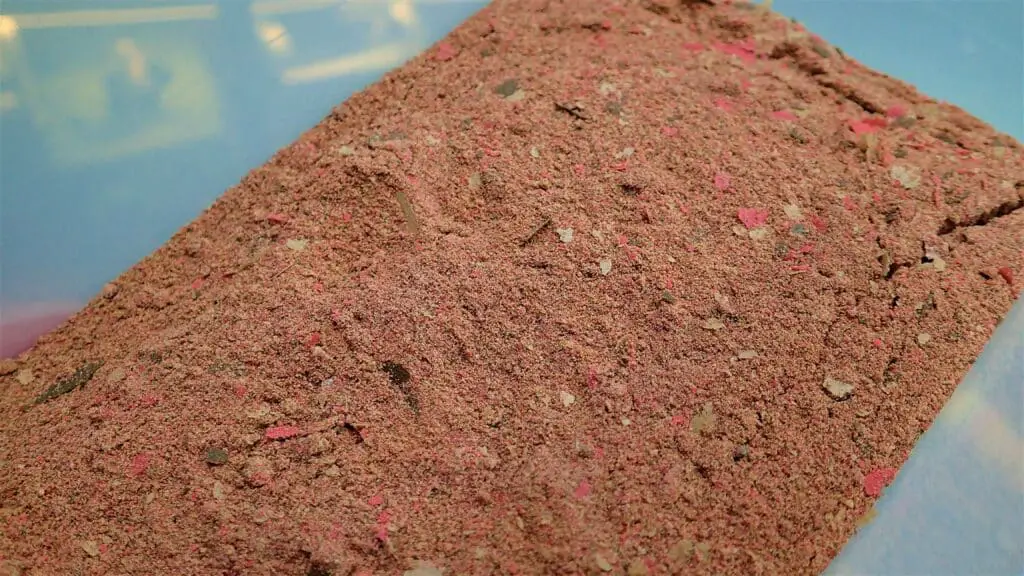
Feeding Your Shrimp and Fish
A well-fed community tank is essential for maintaining harmony between shrimp and fish. Offer a varied diet to ensure that all inhabitants receive the necessary nutrients. Consider the following feeding tips:
- Feed your fish a mix of high-quality flakes, pellets, and frozen foods, such as brine shrimp and daphnia.
- Supplement your shrimp’s diet with blanched vegetables, such as zucchini and spinach, and sinking pellets specifically designed for shrimp.
- Offer algae wafers or tablets to algae-eating fish like Otocinclus Catfish and Bristlenose Plecos.
- Use feeding dishes to keep uneaten food from spreading throughout the tank, and remove any leftover food within 24 hours to prevent water quality issues.
Regularly observe your aquatic pets during feeding times to ensure that both shrimp and fish are getting enough to eat. Adjust feeding routines and portions as needed to maintain a healthy and harmonious environment.
and fish are getting enough to eat. Adjust feeding routines and portions as needed to maintain a healthy and harmonious environment.
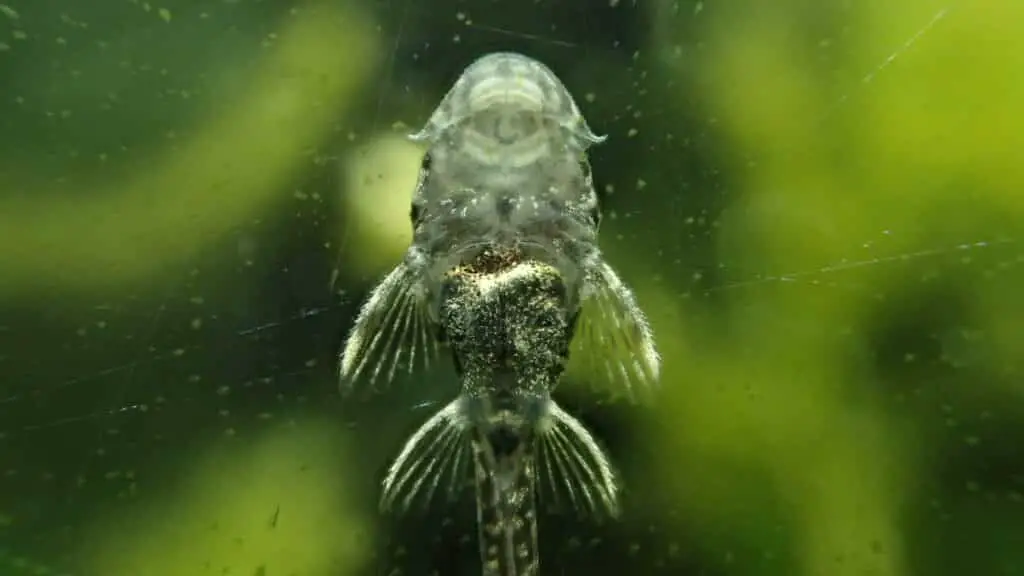
Breeding Shrimp and Fish in a Community Tank
Breeding shrimp and fish in a community tank can be a rewarding experience, but it requires additional considerations to ensure success:
- Research the breeding requirements for your specific shrimp and fish species, as conditions like temperature, water parameters, and tank setup can impact breeding success.
- Provide ample hiding spots and breeding areas, such as dense plant cover, caves, and moss, to encourage spawning behavior and protect developing fry.
- Consider adding a sponge filter or mesh guard to your filter intake to prevent shrimp and fish fry from being sucked into the filter system.
- Be prepared to separate breeding pairs or fry if necessary, as some fish species may become aggressive during breeding or may prey on their own offspring.
Breeding shrimp and fish in a community tank can be challenging, but with proper research, planning, and care, it is possible to create a thriving, self-sustaining ecosystem.
Conclusion
Creating a harmonious shrimp and fish tank is achievable with careful planning and attention to detail. By selecting compatible shrimp safe fish, providing a suitable environment, and maintaining proper water parameters, you can enjoy a thriving, visually stunning aquarium.
Remember that no aquarium fish is completely shrimp safe , but with the right care and setup, it is possible to minimize predation and create a healthy, balanced aquatic ecosystem.
, but with the right care and setup, it is possible to minimize predation and create a healthy, balanced aquatic ecosystem.

FAQs: Your Fish And Shrimp Tank Mate Questions
Q: What fish are safe to keep with shrimp?
A: While no fish is entirely safe with shrimp, some species are more compatible and less likely to prey on them. Guppies, Endlers, Neon Tetras, Ember Tetras, Pygmy Corydoras, Otocinclus Catfish, Harlequin Rasboras, Celestial Pearl Danios, Dwarf Gouramis, and Rummy Nose Tetras are among the best shrimp safe fish options.
Q: What fish should I avoid when keeping shrimp?
A: Avoid fish that are territorial, aggressive, or significantly larger than shrimp, as they are more likely to view them as food. Cichlids, for example, should be avoided due to their territorial nature. Large predatory fish like Oscars and Arowanas are also unsuitable for shrimp tanks.
Q: Can shrimp and fish live together in an aquarium?
in an aquarium?
A: Yes, shrimp and fish can live together in an aquariums if you choose compatible species, provide a suitable environment, and ensure the well-being of both types of aquatic pets. Proper tank size, hiding spots, and regular feeding can help maintain a peaceful community tank.
Q: What is the best fish to keep with cherry shrimp as a tank mate?
A: Some of the best fish to keep with cherry shrimp are Guppies, Endlers, Neon Tetras, Ember Tetras, Pygmy Corydoras, Otocinclus Catfish, Harlequin Rasboras, Celestial Pearl Danios, Dwarf Gouramis, and Rummy Nose Tetras. These fish are peaceful, small, and less likely to prey on shrimp, making them suitable tank mates.
Q: How do I ensure that my shrimp are not eaten by my fish?
A: To minimize the risk of predation, choose shrimp safe fish species, provide plenty of hiding spots for your shrimp using plants and decorations, and ensure that your fish are well-fed. It is also essential to maintain proper water parameters and a stable environment to reduce stress on your shrimp, making them less vulnerable.
Q: What kind of shrimp are best for a community tank?
A: Cherry Shrimp, Amano Shrimp, Ghost Shrimp, Bamboo Shrimp, and Snowball Shrimp are all suitable for a community tank with shrimp safe fish. Each shrimp species has its own specific care requirements, so it’s crucial to research their needs and compatibility with your existing or planned fish before introducing them to your tank.
Q: Can I breed shrimp in a community tank with fish?
A: Breeding shrimp in a community tank with fish can be challenging but is possible with proper planning and care. Provide ample hiding spots and breeding areas, research the breeding requirements for your specific shrimp species, and be prepared to separate breeding pairs or fry if necessary to ensure their safety.
